
By William Henry
The United States Capitol, rising atop Capitol Hill in the monument city of Washington, D.C. may well be the most famous building in the world.
To Americans the cast-iron, Capitol dome, dressed in pure white sandstone, is a symbol of strength and democracy. Radiant. Luminous. Shining. Freedom rings from this beautiful bell. How many recognize the Capitol is a temple?
Thomas Jefferson called it “The first temple dedicated to the sovereignty of the people.”
An anonymous essay of 1795 described the Capitol building as a ‘temple erected to Liberty’.
Specifically, the founders of the Capitol Temple likened it to Solomon’s Temple in Jerusalem.
“I have every hope that the grand work we have done today will be handed down…to a late posterity, as the like work of that ever memorable temple to our order erected by our ancient Grand Master Solomon.” Maryland Grand Master Joseph Clark, September 18, 1793, at the laying of the cornerstone of the Capitol.
“It would be unbecoming the representatives of this Nation to assemble for the first time in this solemn Temple without looking up to the Supreme Ruler of the Universe and imploring His blessing.” President Adams, November 22, 1800, opening the Second Session of the Sixth Congress in the new Capitol building.
These words are more than poetic. The U.S. Capitol has numerous architectural and other features that unquestionably identify it with ancient temples including stone construction, an underground entrance, chapels, an image of a deified being, religious imagery, symbols, and inscriptions, divine proportions, massive columns, palpable spiritual energy, acoustic trickery, terrifying guardians, mystic visitors, closed doors, private members, secret chambers, and orientation to the Sun.
It is crystal clear that the builders viewed the Capitol as America’s sole temple (a solemn, Solomon’s Solar Temple to be exact).
THE DOME AT THE HEART OF AMERICA
The dome of the Capitol ices this connection. Domes have been called the perfect architectural shape: the circle, symbol of the universe, executed in three dimensions.
In religious architecture domes proclaim the glory of God. The word dome comes from Latin domus, a house, via Italian duomo, a house of God, that is a church (from kirk, meaning ‘circle’). The temple is a “house of the holy”. Temple is also a word for the flat part on either side of the human head, called a dome in slang, above and beyond the eye.
The oculus or eye of the dome is considered the Gateway of the Sun. From this gateway at the top of the dome rises the World Axis, the link between heaven and earth. Domes, therefore, are the threshold or gateway of the spiritual world.
Designed in 1854 by Philadelphia architect Thomas Walter, the cast-iron U.S. Capitol dome (its second) features stunning columns, pilasters, windows crowned by a statue of the goddess Freedom. When funds ran low during the Civil War Abraham Lincoln encouraged continuing the controversial construction of the New Dome as a symbol of unity.
The Capitol Rotunda is a large, circular room located in the center of the Capitol on the second floor. 96 feet in diameter, it is the symbolic and physical heart of the U.S. Capitol. It is the ceremonial center of the United States of America.
More directly, it is a place of American ritual. Rites are performed here. Statues, such as the one of Eisenhower, are unveiled here. Inaugurations take place here. Eminent citizens lay in state here. It was the body of Abraham Lincoln, the first president to be assassinated, laying in state which has forever hallowed the spot.
GEORGE WASHINGTON IN THE SUN (OR STAR) GATE
Hanging 180 feet above the floor of the Rotunda, in the canopy of the interior Dome is the single most important work of alchemy anywhere in the world.
Painted in true fresco, it’s called “The Apotheosis of George Washington.” The Italian painter, Constantino Brumidi, painted it during the Civil War. A renowned Vatican painter, Brumidi came to the United States in 1852, after he had received a papal pardon for his role in Italy's republican revolution. He was inspired by Michaelangelo’s last great work, the Dome of St. Peters. He is called “the Michaelangelo of the Capitol.”
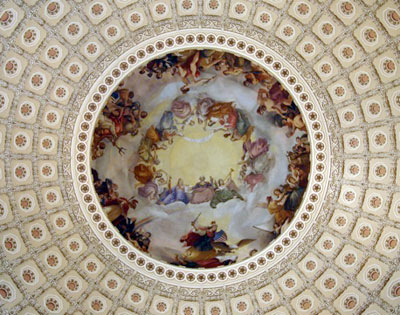
The Dome of the U.S. Capitol. Photo: Wm. Henry
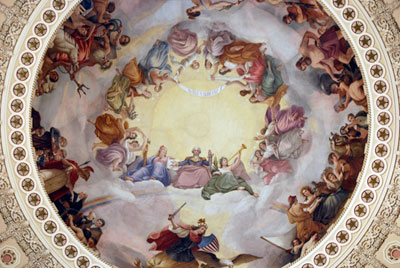
Detail of Washington on a rainbow and surrounded by stars. Photo: Wm. Henry
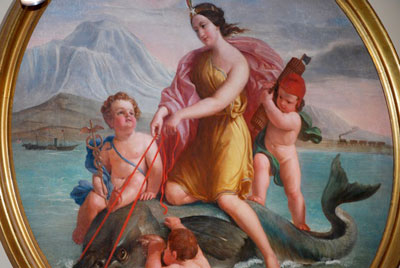
On the first floor of the Senate wing of the Capitol are the Brumidi Corridors, said to be among the most ornate and creatively decorated public spaces in the nation. They combine classical imagery with patriotic American themes. Photo: Wm. Henry
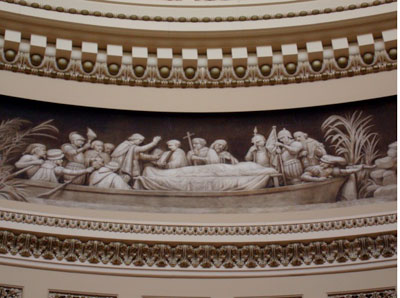
The frieze of the Rotunda showcases Brumidi’s mastery of creating the illusion of three-dimensional forms and figures on flat surfaces. Photo: Wm. Henry
Floating in the center of the “Apotheosis”, a uniformed Washington sits enthroned on a rainbow in front of a Sun gate. Liberty, holding her fasces (a goddess symbol of transformation), and a combination of Victory and Fame sounding a trump flank him.
Apotheosis is a Greek word that means ‘to raise to god like stature’ or the glorification of a person as an ideal. Indeed, this fresco depicts Washington as a god-man. Christian art portrays Jesus sitting on a rainbow and enthroned exactly the same way. The sun is a symbol of Christ from the prophecy of Malachi 4:2 “But unto you that fear my name shall the Sun of righteousness arise with healing in his wings.”
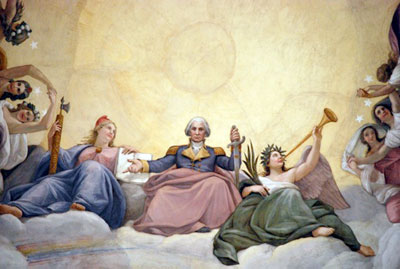
Washington enthroned on a rainbow with sun gate behind him. Wm. Henry
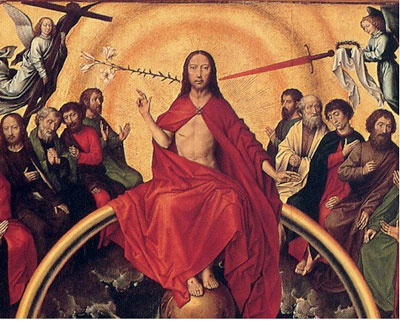
Detail of Jesus enthroned on a rainbow with celestial beings all around him. Note the ‘sun gate’ behind him
Tibetan artists use identical imagery to portray their high holy ones (called lamas) who have achieved “The Great Perfection” (Dzogchen). The aim of the Great Perfection is to awaken the individual to the primordial state of enlightenment, which is naturally found in all beings. The initiate’s goal is to integrate enlightenment into all his or her activities and to unite the physical body with the energy of Nature. The supreme realization of which lies in the manifestation of the “Rainbow Body” or body of light.
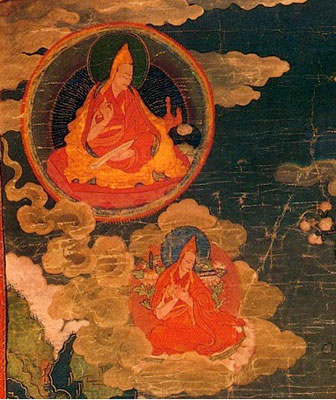
A lama rides in a rainbow
This is the meaning behind the symbolism of both Jesus and George Washington sitting on the rainbow. Washington is a perfected human, not only a Grand Master, but also an ‘American Christ’, in tune with his divine nature. He is now somewhere over the rainbow, and is a bridge between Heaven and Earth.
Perfection is the foundation tantra of the European Enlightenment thinkers Locke, Voltaire and Rousseau who inspired the deeply spiritual, even mystic, founders of America (many of whom were Freemasons and Rosicrucians). Human beings are not inherently depraved or sinful, Enlightenment thinkers reasoned, we are naturally good.
Tearing a page from Plato’s Republic, they saw enlightenment as a process of revealing what is already inside the person; self-perfection into the Gnostic “Man of Light”. The Enlightened ones of Tibet say the same thing only adding that perfection or holiness is the natural state of every living being whether they know it or not and that we also have the capacity to manifest perfection (= Rainbow Body).
The Founders had a vision of America as a psychological space and a place where individuals were free to perfect themselves, or in Jefferson’s multi-layered language to form ‘a more perfect union’.
The circle or ‘gate’ of 72 stars that surrounds Washington affirms this philosophy. 72 is a powerful esoteric number with numerous correspondences in the Mysteries. 72 represents the number of years on one degree of a zodiacal age. Manly P. Hall’s “The Secret Destiny of America” has an interesting interpretation of the 72 stones in pyramid of the Great Seal. He sees them corresponding to the 72 arrangements of the Tetragrammaton, or the four-lettered name of God, in Hebrew. These four letters can be combined into 72 combinations, resulting in what is called the Shemhamforesh, which represents, in turn, the laws, powers, and energies of Nature by which the perfection of man is achieved.
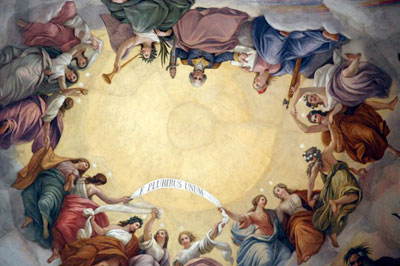
13 star beings surround George Washington
Thirteen female figures encircle Washington, each with a star above her head. They are thought to represent the thirteen original states. However, this is not an earthly scene. They are 13 star beings.
Surrounding Washington are seven mythological figures that correspond to the seven stages of alchemy. Included is Poseidon, the ruler of Atlantis and Mercury and Vulcan, two gods synonymous with alchemy.
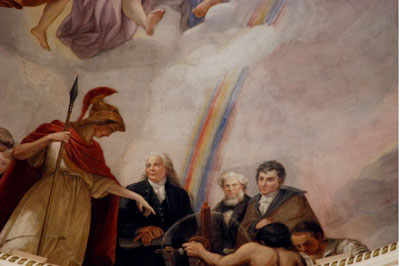
Minerva with Benjamin Franklin at the end of the rainbow. Wm. Henry
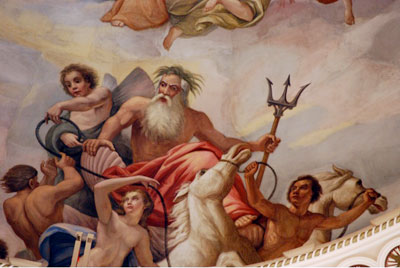
Poseidon, ruler of Atlantis. Wm. Henry
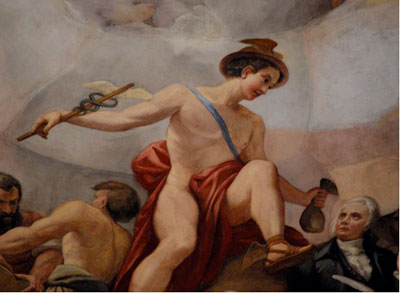
Mercury, the messenger of the gods. Wm. Henry
THE STAIRWAY TO HEAVEN
An imaginary vertical line descending from the Sun gate in the dome travels through a golden dot at the center of the Rotunda, then through a star in a large circular room called the Crypt one story beneath the Rotunda. The Latin crypta means “hidden” or “secret.” A crypt is usually found in cemeteries and under public religious buildings, such as churches and cathedrals. It’s a burial place, but also, importantly, a meeting place.
The star in the crypt marks the literal ground zero in Washington. It divides the city into four quadrants, and every address in the city tells you where you are in relation to that precise point in the U.S. Capitol building. This is just another open (yet hidden) hint as to the significance of that particular gold dot.
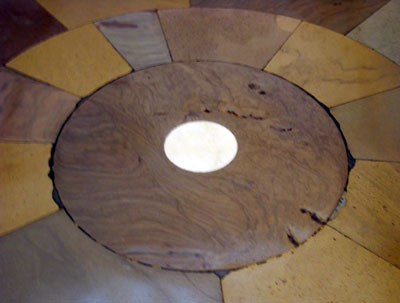
The golden dot at the center of the Rotunda. Wm. Henry
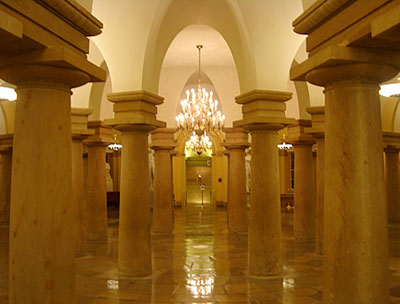
The Capitol Crypt was originally built to support the Rotunda. It has 40 neo-classical columns modeled after the Temple of Poseidon in Greece. Wm. Henry
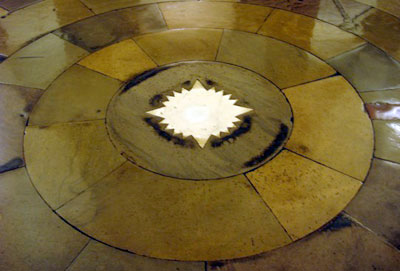
The star in the center of the Crypt. Wm. Henry
Architectural historians link the crypt with the unconscious and the chtonic, subterranean or earthly realm. This is based on the medieval belief that the cathedral was the body of Christ and a symbol also of Man. The body and spirit, encased in a coffin or casket, is ‘planted’ in the crypt to resurrect or rise.
A crypt is also an entrance to a tomb. Indeed, the Capitol’s Crypt provides an entrance to Washington’s Tomb, which is located one story beneath the Crypt.
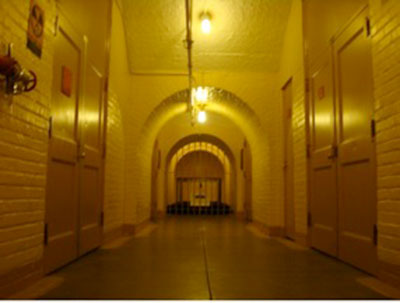
The hallway leading to Washington’s Tomb located one story beneath the Crypt. Wm. Henry
Washington’s Tomb is empty. Why? The tomb was never used to inter Washington’s body. The plans to place his casket there were scuttled by a legal issue in Washington’s will. His grave is at Mount Vernon, the President’s home.
A more compelling answer is because Washington is on the ceiling of the dome… in the heavens above. The story of these three Capitol stories is that Washington has risen. Just like Jesus’s tomb (and the King’s Chamber of the Great Pyramid) Washington’s is empty because the man is now a deity.
This perspective conjures the image of the Capitol as a temple of transformation or even a casket.
THE TEMPLE OF MAN
The work of French Egypt-alchemy explorer Schwaller de Lubicz, presented in his work, “The Temple In Man: Sacred Architecture and the Perfect Man”, leads a to major breakthrough in our understanding of the Capitol-is-a-casket story.
De Lubicz’s work centered on the Temple of Luxor, located 2 miles from Thebes, Egypt’s Vatican. The plan for this temple, he demonstrated, is based on human proportions and designed to symbolically represent the human body. It is an open book containing the secrets of human spiritual anatomy. In this temple he found a human being embodied in the geometry of the Temple’s architecture. This, he concluded is Pharaoh, symbolic of the Perfect Man.
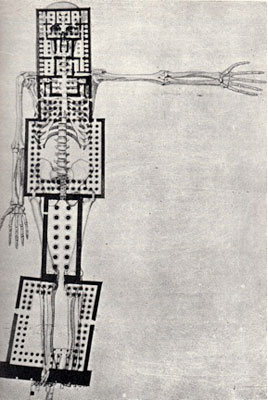
Projection of the Temple of Luxor on a human skeleton
The Temple of Man was built by Ramses II in the 13 century B.C. as a setting for the rituals of the Festival of Opet. The word ‘Opet’ means ‘Secret Chamber’. So it is “the Festival of the Secret Chamber.”
During this festival the king would make a ceremonial precession from Karnak along the avenue of Sphinxs to the temple of Luxor, located 2 miles away. The king would make his way to one of the innermost chambers of the temple. There, the king and his divine essence (called the ka, and created at his birth), were united and the king transformed into a divine being. The crowd, waiting anxiously, their belly’s full of bread and beer provided by the king for the rite, would cheer wildly upon the king’s emergence as the transformed or transfigured god-man.
The Festival affirmed and renewed the king’s Divine Right to Rule. It assured the people that the power of the Cosmos was renewed in the king.
Projecting the image of the Temple of Luxor on the U.S. Capitol, which is divided into seven chambers that correspond with the charkas, reveals a provocative match. The House of Representatives corresponds with the feet. The Rotunda is the womb. The Senate is the head.
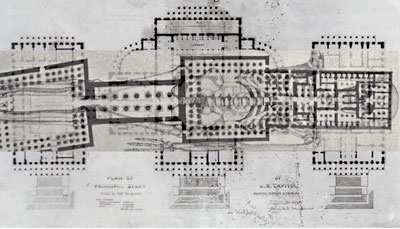
Projection of the Temple of Luxor and human skeleton upon Latrobe’s plan of the U.S. Capitol
It is ironic that that U.S. Capitol mimics the sacred layout of Luxor temple considering that America was founded to abolish the Divine Right of Kings. Nonetheless, the spectacle of the Opet Festival is echoed in the inauguration ceremonies of U.S. Presidents as head of state or head of government. This term means that the President is above party politics.
The word inaugural comes from ancient Rome where priests called augurs interpreted the will of the gods by reading the flight patterns of birds. The word augur is thought to be derived either from the root aug, “to increase, to prosper” or from the Latin avi and gero, the Latin “directing of birds.”
In this lavish American ceremony, initiation or rite, politicians stand at the gate of the Secret Chamber, the Capitol Rotunda, in front of hundreds of thousands of spectators (and millions more watching on TV) to take the oath of office and to renew the office of the President. It is strikingly similar to coronations and enthronements. The crucial difference is that the people elected the individual being sworn in to be their head (or ‘present Id’ to use a Freudian term for the instinctual aspect of our psychic apparatus).
Originally, the word inauguration referred to the sacred marriage, the symbolic mating of the new king with the goddess of the kingdom. Scholars point to the Irish Feast of Tara, at which the king married the goddess Medb.
In America the goddess is named Freedom, Liberty and America. Her statues are abundant on the Hill and in the Capitol. She stands on top of the Capitol. Why? It could be because, symbolically, she ‘owns’ it.
Traditionally, the swearing in takes place on the East Portico. For the first time ever, an inauguration took place on the West Terrace of the Capitol when Ronald Reagan took office in 1981. The west side would accommodate more visitors. Reagan’s second inaugural ceremony in January, 1985 took place in the Rotunda due to weather.
President Barack Obama also chose the West Terrace. After being sworn in at noon, the newly anointed President enters the Capitol Temple. He ascends 33 steps into the Rotunda. He looks up. He first sees Mercury, then, he sees the deified Washington peering down at him, challenging him to be an enlightened American leader.





No comments:
Post a Comment